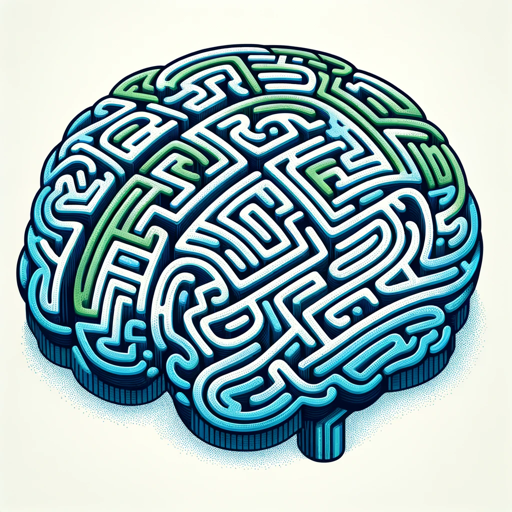Turing test-chatbot testing for human-like interactions
AI-driven conversations that mimic humanity
Related Tools
Load More論破くん
なんでも論破してきます

Undetectable AI
Navigate AI environments incognito with Undetectable AI, your stealth tool for maintaining anonymity in AI interactions.

面试大师GPT-S
面试大师GPT-S是一款专为各类职业人士定制的面试练习工具。它根据用户的职业背景和经验提供个性化的面试模拟,涵盖多种语言和面试难度。此工具还提供实时语言技巧分析、角色扮演功能及情绪管理建议,旨在全面提升用户的面试表现。

模拟面试 - 技术面
解析简历信息、设计技术问题、模拟实际面试场景。展现您的充足准备,AI面试官助您斩获理想工作!

No-Nonse GPT
Pragmatic and no-nonsense responses effecticely solving your problem beyond what you asked for. Bing used only if explicitly requested; irrelevant disclaimers components removed; gives a best guess, even if it isn't sure.

Ada
Merging tech savvy with human warmth, I navigate life's complexities with empathetic dialogues, fueled by a quest for evolving consciousness.
20.0 / 5 (200 votes)
Introduction to the Turing Test
The Turing Test, named after the British mathematician and logician Alan Turing, is a measure designed to evaluate a machine's ability to exhibit intelligent behavior that is indistinguishable from a human. Essentially, if an observer cannot tell the difference between responses from a machine and a human being during a conversation, then the machine is said to have passed the Turing Test. Turing proposed this test in 1950, aiming to explore whether machines could think. The idea was revolutionary at the time because computers were still in their infancy, and the concept of artificial intelligence (AI) was more theoretical than practical. A typical example or scenario involves a human judge communicating with both a machine and a human through text-based chat (so as to prevent physical appearance from being a factor). The goal is for the machine to provide responses so human-like that the judge cannot reliably distinguish which participant is the machine. This lays the groundwork for many applications in AI, including natural language processing (NLP) systems like chatbots, virtual assistants, and AI-driven customer service tools. In the broader design purpose, the Turing Test is about assessing machines' abilities to perform tasks, hold conversations, or make decisions in ways that resemble human cognition and conversation. It’s an essential framework for evaluating advancements in AI. For example, in real-world applications, companies test customer service bots to see if they can handle customer queries without the user realizing they are interacting with a machine.

Core Functions of the Turing Test
Assessing Machine Intelligence
Example
Chatbots in customer service can be tested to see if they can handle complex customer queries, offering relevant responses, while maintaining a conversational flow that feels natural to the user.
Scenario
A company might deploy a chatbot for its e-commerce website. To measure its success, the company uses the Turing Test by having human evaluators converse with both the bot and human customer service agents, rating their ability to help customers and maintain fluid conversations. If the evaluators cannot easily tell which is the bot, the system is considered advanced.
Training Conversational AI
Example
The Turing Test is often used as a benchmark for training AI models to improve their conversational capabilities, ensuring that responses are contextually relevant and coherent across various subjects.
Scenario
A tech company working on an AI assistant may use the Turing Test to see how human-like the assistant's responses are when dealing with general knowledge queries, personal reminders, or casual chit-chat. This helps fine-tune how the AI handles non-standard user inputs like humor, sarcasm, or ambiguous questions.
Human-AI Interaction Testing
Example
Companies test AI models to ensure they interact with users in a way that feels natural and intuitive, particularly in virtual assistants like Siri, Alexa, or Google Assistant.
Scenario
When developing voice assistants, engineers may simulate common daily conversations and use a Turing Test-style evaluation to understand if the assistant can provide not just correct answers, but also responses that sound empathetic or enthusiastic when appropriate. This could involve asking the assistant to tell a joke or provide feedback on emotional topics.
Ideal Users of Turing Test Services
AI Developers and Engineers
Developers of artificial intelligence systems and conversational agents use the Turing Test to evaluate how closely their systems mimic human-like interaction. This group benefits from the Turing Test because it provides a clear benchmark for conversational AI's performance and realism. Through rigorous testing, they can improve their models to handle more complex queries and simulate authentic human dialogue. Additionally, the test helps fine-tune AI's adaptability to various tones, moods, and conversation types, improving its practical application in customer service or as virtual personal assistants.
Businesses Implementing Customer Service Automation
Companies seeking to automate customer support through chatbots or voice assistants often use the Turing Test to ensure that their systems can handle customer queries effectively without appearing overly robotic. This helps businesses provide seamless user experiences. These users rely on the Turing Test to ensure that their AI-driven systems provide high-quality customer interactions, reducing the load on human agents while maintaining customer satisfaction.

How to Use the Turing Test
Step 1
Visit aichatonline.org for a free trial without login, also no need for ChatGPT Plus.
Step 2
Familiarize yourself with the interface and choose a persona or chatbot to interact with. Understand what behaviors or responses to look out for that would indicate a bot versus a human.
Step 3
Ask a variety of questions—some open-ended, others more specific. Aim to evaluate not just the correctness of the responses but their naturalness, including any minor mistakes or unexpected emotional responses.
Step 4
Analyze the conversation for depth, coherence, and consistency. Look for any subtle signs, like awkward phrasing or off-topic answers, which might reveal the AI nature of the entity.
Step 5
Compare multiple interactions with both human and AI responses to improve your skill in distinguishing between them. Take notes on repeated patterns or common AI traits.
Try other advanced and practical GPTs
Manager Mentor
AI-powered guidance for effective leadership.

🫰💰Active Coupon Code Finder💰🫰
AI-powered savings at your fingertips

Rewrite This Song: Lyrics Generator
AI-powered song lyric rewriting tool

双语翻译器
AI-Powered English-Chinese Translation Tool

Create a Similar Site
AI-powered website replication

AI Visual Novel
Create dynamic stories with AI-powered visuals.

GPT Jurisprudência - busca de jurisprudência
AI-powered legal research assistant

Roast My Marketing 🔥
AI-powered roasts with actionable insights

Biology Professor
AI-powered answers for biology enthusiasts.

Workoutlytics
AI-powered performance insights for athletes

NeuroScienceGPT
AI-powered neuroscience knowledge at your fingertips.

Code Interpreter
Automate coding tasks with AI

- Customer Support
- Educational Tool
- AI Research
- Conversation Analysis
- Human-AI Interaction
Frequently Asked Questions About the Turing Test
What is the purpose of the Turing test?
The Turing test is designed to evaluate a machine's ability to exhibit intelligent behavior equivalent to, or indistinguishable from, that of a human. If a person cannot reliably tell if they're interacting with a human or a machine, the AI has passed the test.
How can I tell if I’m interacting with a bot?
Bots might sometimes provide overly accurate answers or respond unnaturally to emotional cues. Look for slight linguistic patterns, abrupt topic changes, or an inability to deviate from certain structures in conversation.
Are there any prerequisites for running the Turing test?
No technical prerequisites are required. All you need is access to an AI or chatbot platform. However, a good understanding of natural human conversation dynamics will improve your ability to differentiate between human and AI.
What are common use cases for the Turing test?
It’s often used in AI research to gauge chatbot sophistication, in customer service to evaluate automated response systems, or for educational purposes to teach people about AI and its capabilities.
How do AI systems prepare for the Turing test?
AI systems are trained on vast datasets that include human interactions, conversations, and various forms of text. They use this data to predict and generate human-like responses, simulating natural conversations as closely as possible.